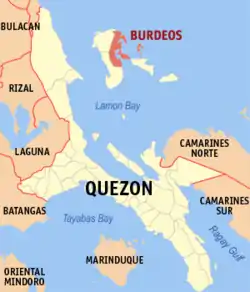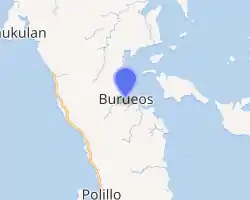Burdeos
Burdeos, officially the Municipality of Burdeos (Tagalog: Bayan ng Burdeos), is a 4th class municipality in the province of Quezon, Philippines. According to the 2015 census, it has a population of 26,760 people. [4]
- Burdeos may also refer to the French city Bordeaux, called Burdeos in Spanish.
Burdeos | |
|---|---|
| Municipality of Burdeos | |
 Seal | |
| Etymology: Spanish for Bordeaux | |
 Map of Quezon with Burdeos highlighted | |
OpenStreetMap 
| |
.svg.png.webp) Burdeos Location within the Philippines | |
| Coordinates: 14°50′37″N 121°58′11″E | |
| Country | |
| Region | Calabarzon (Region IV-A) |
| Province | Quezon |
| District | 1st District |
| Founded | June 12, 1948 [1] |
| Named for | Bordeaux, France |
| Barangays | 13 (see Barangays) |
| Government | |
| • Type | Sangguniang Bayan |
| • Mayor | Freddie C. Aman |
| • Vice Mayor | Gina P. Gonzales |
| • Representative | Wilfrido Mark M. Enverga |
| • Electorate | 12,438 voters (2019) |
| Area | |
| • Total | 199.82 km2 (77.15 sq mi) |
| Elevation | 48 m (157 ft) |
| Population | |
| • Total | 26,760 |
| • Density | 130/km2 (350/sq mi) |
| • Households | 5,634 |
| Economy | |
| • Income class | 4th municipal income class |
| • Poverty incidence | 40.88% (2015)[5] |
| • Revenue | ₱85,651,113.83 (2016) |
| Time zone | UTC+8 (PST) |
| ZIP code | 4340 |
| PSGC | |
| IDD : area code | +63 (0)42 |
| Climate type | tropical rainforest climate |
| Native languages | Tagalog |
| Website | www |
Burdeos was created in 1948 from the barrios of Burdeos, San Rafael, Amot, Aluyon, Magdalo, Patnanungan, Calotcot, Karlagan and Palasan island which then belonged to the town of Polillo, Quezon.[6]
Geography
The municipality of Burdeos is geographically located in the coastal part of Polillo Island in the first Congressional District of the Province of Quezon, a town that is trapezoidal in shape, facing the vast Pacific Ocean with an area of approximately 20,948 hectares. Burdeos is composed of 13 barangays, three of which are island barangays, with 25 islands which are potential tourist spots. The territorial water of this municipality is a good fishing ground with abundant aquatic resources.
Barangays
Burdeos is politically subdivided into 13 barangays.
- Aluyon
- Amot
- Anibawan
- Bonifacio
- Cabugao
- Cabungalunan
- Calutcot
- Caniwan
- Carlagan
- Mabini
- Palasan
- Poblacion
- San Rafael
Climate
| Climate data for Burdeos, Quezon | |||||||||||||
|---|---|---|---|---|---|---|---|---|---|---|---|---|---|
| Month | Jan | Feb | Mar | Apr | May | Jun | Jul | Aug | Sep | Oct | Nov | Dec | Year |
| Average high °C (°F) | 26 (79) |
27 (81) |
28 (82) |
30 (86) |
31 (88) |
30 (86) |
30 (86) |
30 (86) |
29 (84) |
29 (84) |
28 (82) |
26 (79) |
29 (84) |
| Average low °C (°F) | 21 (70) |
21 (70) |
22 (72) |
23 (73) |
24 (75) |
25 (77) |
24 (75) |
24 (75) |
24 (75) |
23 (73) |
23 (73) |
22 (72) |
23 (73) |
| Average precipitation mm (inches) | 33 (1.3) |
26 (1.0) |
26 (1.0) |
30 (1.2) |
109 (4.3) |
165 (6.5) |
187 (7.4) |
163 (6.4) |
162 (6.4) |
147 (5.8) |
85 (3.3) |
74 (2.9) |
1,207 (47.5) |
| Average rainy days | 10.2 | 7.6 | 9.6 | 10.5 | 19.9 | 23.6 | 26.0 | 24.8 | 24.5 | 19.6 | 12.7 | 13.0 | 202 |
| Source: Meteoblue [7] | |||||||||||||
Demographics
|
| |||||||||||||||||||||||||||||||||||||||
| Source: Philippine Statistics Authority [4] [8] [9][10] | ||||||||||||||||||||||||||||||||||||||||
Local government
Municipal officials 2016-2018:
- Mayor: Freddie C. Aman
- Vice Mayor: Obren Tan
- Councilors:
- Alice C. Cuerdo
- Esmenia Portillo
- Danilo C. Ungriano
- Supli Suplido
- Haide Ayuso
- Jorge Morga
- Ama Turgo
- Ernesto Ayuma
See also
References
- http://www.chanrobles.com/republicacts/republicactno250.html
- Municipality of Burdeos | (DILG)
- "Province: Quezon". PSGC Interactive. Quezon City, Philippines: Philippine Statistics Authority. Retrieved 12 November 2016.
- Census of Population (2015). "Region IV-A (Calabarzon)". Total Population by Province, City, Municipality and Barangay. PSA. Retrieved 20 June 2016.
- "PSA releases the 2015 Municipal and City Level Poverty Estimates". Quezon City, Philippines. Retrieved 1 January 2020.
- "An act creating the municipality of Burdeos in the province of Quezon". LawPH.com. Retrieved 2011-04-08.
- "Burdeos: Average Temperatures and Rainfall". Meteoblue. Retrieved 25 January 2020.
- Census of Population and Housing (2010). "Region IV-A (Calabarzon)". Total Population by Province, City, Municipality and Barangay. NSO. Retrieved 29 June 2016.
- Censuses of Population (1903–2007). "Region IV-A (Calabarzon)". Table 1. Population Enumerated in Various Censuses by Province/Highly Urbanized City: 1903 to 2007. NSO.
- "Province of Quezon". Municipality Population Data. Local Water Utilities Administration Research Division. Retrieved 17 December 2016.
